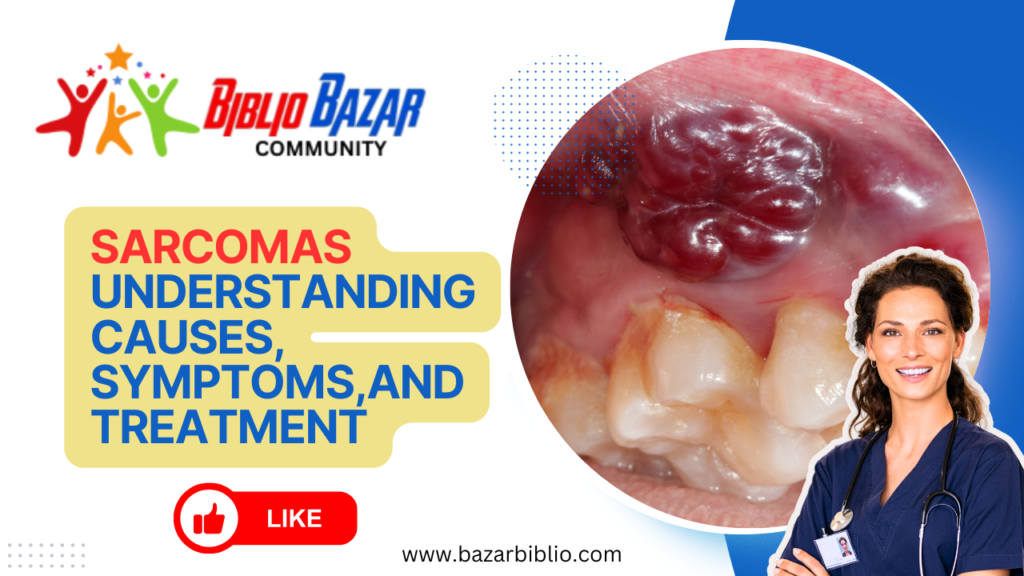
Sarcomas are a diverse group of cancers originating in the bones and soft tissues, which include fat, muscles, blood vessels, nerves, tendons, and the lining of joints. Though rare, they are particularly serious due to their ability to affect any part of the body. Understanding sarcomas is crucial for early detection and effective treatment.
Types of Sarcomas

There are two main types of sarcomas: bone sarcomas and soft tissue sarcomas.
- Bone Sarcomas: These include osteosarcoma, which typically affects the long bones of the arms and legs; Ewing’s sarcoma, often found in bones and the surrounding soft tissues; and chondrosarcoma, which begins in the cartilage.
- Soft Tissue Sarcomas: This broad category includes subtypes such as liposarcoma (fat), leiomyosarcoma (smooth muscle), and angiosarcoma (blood vessels). These tumors can develop in various tissues, making their diagnosis and treatment complex.
Causes and Risk Factors

The exact causes of sarcomas remain unclear, but they are believed to arise from a combination of genetic mutations and environmental factors. Key risk factors include:
- Genetic Conditions: Certain inherited syndromes, such as Li-Fraumeni syndrome and neurofibromatosis, increase the risk of developing sarcomas.
- Radiation Therapy: Previous radiation treatment for other cancers can lead to sarcomas in the treated area years later.
- Chemical Exposure: Long-term exposure to certain chemicals, like vinyl chloride, is linked to a higher risk of developing sarcomas.

The symptoms of sarcomas vary based on their location but often include:
- Lump or Swelling: A noticeable lump under the skin, which may or may not be painful.
- Pain: Persistent pain, especially if the tumor compresses nerves or muscles.
- Reduced Range of Motion: Difficulty moving the affected limb or joint.
- Bone Pain or Fractures: In cases of bone sarcomas, unexplained bone pain or fractures may occur.
Treatment Options
Treatment for sarcomas typically involves a combination of surgery, radiation therapy, and chemotherapy:
- Surgery: The primary treatment for localized sarcomas, aiming to remove the tumor completely. Limb-sparing surgery is often possible, but in some cases, amputation may be necessary.
- Radiation Therapy: Used before surgery to shrink tumors or after surgery to eliminate remaining cancer cells.
- Chemotherapy: Often used for high-grade or advanced sarcomas, either before surgery to reduce tumor size or after surgery to destroy any remaining cancer cells.
- Targeted Therapies and Immunotherapies: Emerging treatments that may be used in specific cases to target cancer cells more precisely.
Surgical Management
Surgical management aims to remove the tumor with clear margins to prevent recurrence. This may involve:
- Limb-Sparing Surgery: Preserving as much of the limb as possible while removing the tumor.
- Amputation: Necessary in some cases to ensure complete removal of the cancer.
- Reconstruction and Rehabilitation: Post-surgical care to restore function and appearance, crucial for the patient’s quality of life.
Nursing Care Plan
Nursing care for sarcoma patients focuses on managing symptoms, providing emotional support, and educating patients and their families. Key aspects include:
- Pain Management: Addressing significant discomfort associated with sarcomas.
- Monitoring Treatment Side Effects: Providing interventions to mitigate side effects of chemotherapy and radiation therapy.
- Psychological Support: Helping patients cope with the emotional impact of a cancer diagnosis and treatment.
subscribe us for more videos like this and visit bazarbiblio.com for notes and free pdf books Thank You
Frequently Asked Questions (FAQs)
- What are sarcomas?
- Sarcomas are cancers that originate in the bones and soft tissues.
- What are the types of sarcomas?
- The main types are bone sarcomas and soft tissue sarcomas.
- What causes sarcomas?
- The exact causes are unclear, but they involve genetic mutations and environmental factors.
- What are the risk factors for developing sarcomas?
- Key risk factors include genetic conditions, previous radiation therapy, and exposure to certain chemicals.
- What are the symptoms of sarcomas?
- Symptoms include lumps or swelling, pain, reduced range of motion, and bone pain or fractures.
- How are sarcomas treated?
- Treatment typically involves surgery, radiation therapy, and chemotherapy.
- What is limb-sparing surgery?
- It is a surgical technique to remove the tumor while preserving as much of the limb as possible.
- What role do nurses play in the care of sarcoma patients?
- Nurses manage symptoms, provide emotional support, and educate patients and families about the disease and treatments.
- What are targeted therapies and immunotherapies?
- These are emerging treatments that target cancer cells more precisely, used in specific cases.
- How important is post-surgical care in sarcoma treatment?
- Reconstruction and rehabilitation are crucial to restore function and appearance, improving the patient’s quality of life.
Discover more from Bibliobazar Digi Books
Subscribe to get the latest posts sent to your email.


